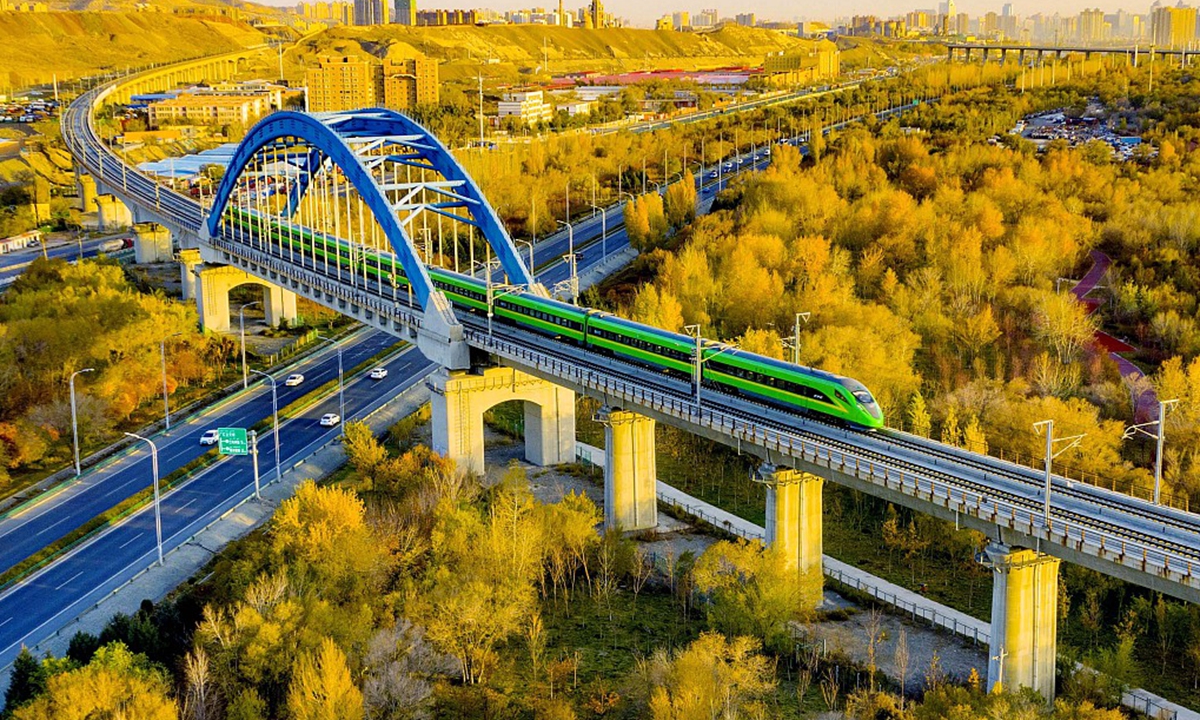
Photo:VCG
The upcoming annual two sessions, set to gather top lawmakers and political advisors from across the country, usually serves as a window for the world to take a look at China's policy-making process and the agenda to growth its economy.
One of the most closely looked agenda is China's official GDP growth target for 2022. Economists told the Global Times that the policymakers are expected to announced a growth rate of above 5 percent, in order to maintain stability of the country's economy amid a downward global trend.
Economists predicted that infrastructure investment will be a key growth driver of the GDP, while effective measures will be announced to increase household incomes to boost domestic consumption. Also, more tax and fee cuts are expected to assist small and medium-sized enterprises.
The two sessions - the National People's Congress (NPC), the top legislative body, and the Chinese People's Political Consultative Conference (CPPCC), the top political advisory body, are scheduled to commence at the weekend in Beijing.
China's growth target is expected to be revealed at the opening of the NPC session on Saturday, when Premier Li Keqiang delivers the annual government work report to the lawmakers.
China's GDP expanded 8.1 percent in 2021, growing the fastest in nearly a decade and landing well above the government's annual target of above 6 percent.
But GDP growth in the fourth quarter slowed to 4 percent year-on-year, down from 4.9 percent in the previous three months. Authorities have warned about the "triple pressure" faced by the Chinese economy, namely shrinking demand, supply shocks and weakening expectations.
Cao Heping, an economist at Peking University, predicted a growth rate of 5-5.5 percent, citing the impact caused by the pandemic and China's switch of focus toward high-quality growth.
"Infrastructure construction can prop up the growth, but it will not be a one-shot deal," Cao told the Global Times on Wednesday. "Now the global economy is facing downward pressure. The pandemic and the geopolitical situation in Europe will bring more uncertainties."
A wave of infrastructure spending has taken place across the country since the beginning of the year.
There could be more financial policy easing efforts in the first half of the year, which is expected to provide adequate liquidity to fire up the GDP growth, Li Changan, professor of the Academy of China Open Economy Studies at the University of International Business and Economics, told the Global Times on Wednesday.
In January, the IMF cut its forecast for China's economic growth in 2022 to 4.8 percent, higher than the world's 4.4 percent, citing disruptions caused by the pandemic and pressure on the country's property sector.
Chinese economists, while admitting challenges are mounting, disagreed with the prediction, noting that China is still poised to achieve a growth rate well above 5 percent, assisted with fiscal and financial stimulus.
So far, the 31 provincial-level regions on the Chinese mainland have all published their economic growth goals, which averaged at about 6 percent - though lower than the 8.1 percent growth in 2021, but still higher than IMF's 4.8 percent prediction for 2022.
Members of the CPPCC also remain confident the economy will achieve a sustainable and healthy growth. "The CPPCC members and Chinese economists are all confident that China has the conditions and capabilities to achieve stable, healthy and sustainable economic growth," Guo Weimin, spokesperson for the 5th session of the 13th National Committee of the CPPCC, said on Thursday at a news briefing.
Apart from the GDP growth, observers will be looking for how China sets its deficit-to-GDP ratio under a proactive fiscal policy in 2022. The economists the Global Times have talked to are giving mixed views.
China's deficit-to-GDP ratio may edge up to 3.2-3.5 percent, Li Chang'an said, noting that in general, China's deficit-to-GDP ratio still has room to grow and is not particularly high compared with Western countries.
In mid-February, China announced 31 important policies including tax and fee cuts, to bolster the services sector, which was crippled by the COVID-19 pandemic. The authorities strongly opposed business shutdowns in the fields of catering, supermarkets, scenic spots and cinemas.
Cao Heping also predicted a deficit-to-GDP ratio of 3.3-3.4 percent. China lowered its budget deficit ratio to 3.2 percent in 2021, compared with 3.6 percent set for 2020, when the COVID-19 outbreak pummeled the economy.
The country's budget deficit has largely stayed below 3 percent of GDP since reform and opening-up started in 1978, except for 2016 and 2017 when the ratio was set at 3 percent.
Lian Ping, head of Zhixin Investment Research Institute, predicted a 3 percent deficit-to-GDP ratio, on a par with last year.
"There's no need to hike the level, since in 2021 about one-third of the quotas for special-purpose bonds were not used. But in the first two months of this year, these bonds were used up in a faster manner, with about 800 billion yuan ($126.59 billion) worth of bonds issued," Lian told the Global Times.




